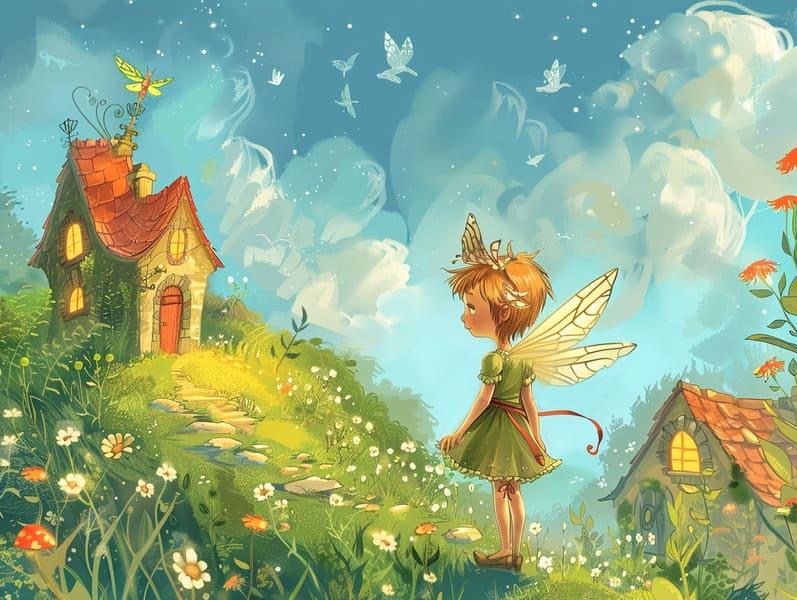
Old fairy tales have old origins. These tales have been conveyed from one generation to the next centuries before they were ever inscribed. They were born from a variety of societies, including Eastern traditions. They were initially shared among adults, often carrying themes and messages relevant to the societal norms and beliefs of the time.
The Brothers Grimm, the two Grimm brothers, were among the first to compile many of these beloved tales. Their anthology, "Grimm's Children's Stories," included narratives like "Cinderella," "The Bread Crumb Trail," and "Snow White," which have since become classics in the world of classic fairy tales. Similarly, Andersen's fanciful tales, such as "The Mermaid's Tale," and "The Little Duckling," have floated into hearts worldwide, solidifying their place in the pantheon of iconic fairy tales.
Though they are centuries old, fairy tales remain as applicable as ever, especially as kids' bedtime tales. These magical stories are now available in multiple formats, including beautifully illustrated books, enchanting animations, and web-based fairy tales.
Their enduring popularity can be connected to several delightful features:
Ethical Lessons: Timeless fairy tales often share important moral lessons. Tales like "The Wolf and the Liar" teach the value of sincerity, while "The Tale of the Tortoise and the Hare" show the benefits of persistence and humbleness. These stories offer young ones clear distinctions between truth and falsehood, guiding their moral compass in a subtle yet meaningful way.
Sympathy and Perception: Old fairy tales frequently present figures facing tests and troubles, inciting children to connect with their struggles and applaud their triumphs. For instance, "The Story of Beauty and the Beast" highlights the merit of seeing inner beauty to appreciate the inner being of a soul, strengthening awareness and discernment.
Cultural Knowledge: Many classic fairy tales are deeply ingrained in the cultural contexts from which they bloomed. Understanding these fairy tales can provide fascinating glimpses into different customs, nurturing a sense of cultural respect and awareness.
Imagination and Innovation: The fanciful elements in ancient fairy tales—magical spells—enhance children’s dreams. These narratives transport readers to fantasy realms, enhancing imaginative ideas and a sense of fascination that continues a lifetime.
Old fairy tales are not only spellbinding but also enlightening. They provide entrancing tools in building various cognitive and emotional skills in children. When traditional fairy tales are voiced, they develop language proficiency by presenting new phrases and detailed sentence structures. This practice also develops listening skills and focus, as children focus on every detail, expectant to see what happens next.
Furthermore, reflecting on the themes and characters of traditional fairy tales can foster reasoning skills and analytical skills. Young readers learn to find patterns, anticipate outcomes, and catch on to cause and effect. These analyses also facilitate little ones articulate their thoughts and feelings, cultivating their emotional intelligence.
In today’s information age, the presence of digital storybooks has made these stories more acquirable than ever. Internet resources and programs give large libraries of popular fairy tales that can be seen or listened on anytime, anywhere. Fairy tales recited are particularly well-liked, extending an engaging way for the young to enjoy these charming stories. Narrated books and read-to-me stories take characters and settings to life, often complemented by whimsical background sounds and music that heighten the narrative journey.
The lasting appeal of classic fairy tales lies in their ability to adapt to modern days while retaining their central messages. Contemporary modernizations of these fairy tales often include more multicultural characters and modern settings, making them pertinent to today’s audience. However, the main ideas of fortitude, sympathy, and righteousness remain unchanged, continuing to affect kids of all ages.
Fairy tales also offer a sense of assurance and closeness. They bestow a coherent narrative with a definite beginning, middle, and end, often ending with the resolution of conflicts and the triumph of good over bad. This assuredness can be placating for young ones, imparting a sense of solidity in an constantly changing world.
Ancient fairy tales continue to spellbind and enlighten new generations, maintaining their magic and meaningfulness in modern society. As children's bedtime stories, they afford a perfect blend of magic and knowledge, enriching moral values, empathy, and creativity. The existence of free fairy tales online and the sought after status of fairy tales read aloud guarantee that these classic stories remain obtainable to new generations.
By keeping and conveying these narratives, we continue to treasure the rich click here tapestry of folklore and cultural heritage. Whether you are delving into a vividly illustrated book, experiencing a electronic collection, or listening through an spoken story, the grace of bedtime fairy tales is always within reach. These tales convey of the continued presence of tales and its ability to draw us together across eras and regions.
Be it you are viewing a gorgeously illustrated book, delving into a online collection, or hearing an spoken story, the appeal of ancient fairy tales is always within reach.
These narratives teach us of the unwavering power of storytelling and its ability to bond us across epochs and places, making a tie that charms and informs alike.